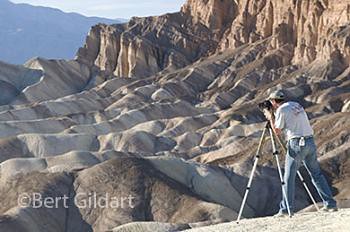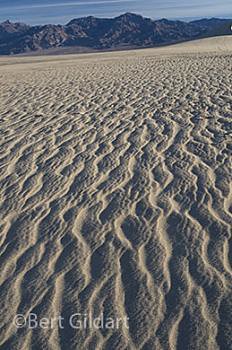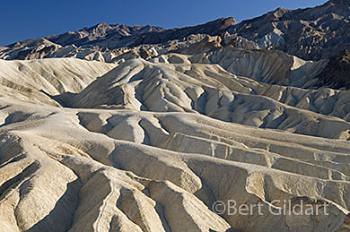Death Valley and the Challenge For Photographers
©Bert Gildart: Death Valley is a photographer’s paradise, and that is one of the reasons we have rendezvoused in this largest of all national parks in the Lower 48 with good friends Eric and Sue Hansen. We all belong to the Outdoor Writer’s Association of America, and it seemed only logical that we could accomplish much by pooling resources. In other words, one day they’d drive another day we’d drive. In the evening we’d enjoy evening cookouts.
The only draw back of being here is that we have no cell phone reception, and at Stove Pipe Wells where we’re camped, we have no Internet. Thirty miles away, however, at Furnace Creek the park provides access to the Internet at its Visitor Center and that is the vicinity to which we’ll soon be moving. When you read this, we will have moved to the campground at Texas Springs-within walking distance of the Visitor Center.
ATTRACTS PHOTOGRAPHERS
It is the austerity of the park that makes this such a joy to photograph and that initially began attracting photographers. Ansel Adams was lured here as well as the Munch family, and they set some pretty high standards. Adams created an entire book of black and white photography on this park, and to a large degree, it is his work that lured me into photography. I still enjoy making black and white images.
One man Eric and I know said he thought Death Valley was the most interesting mass of nothingness he’d ever seen. We considered his thought, but agreed that the point of photography is to find organization when others see confusion. And that’s what we’ve been working at these past few days.
The mining industry also found value in this land of “nothingness” and created a legacy the park inherited and that is now played out in various ways. Once Ronald Regan narrated “Death Valley Days,” a TV series that recalled the hardships miners endured before this part of the Mojave Desert became a park. Though miners such as “Shorty” Harrison and Pete Auguberry hoped to get rich on precious metals, instead many struck it rich with Borax.
DEATH VALLEY DUNES
Eric and I began our photographic explorations with the sand dunes, a place that for pure sensual pleasure is hard to beat. On some February mornings you can strike out across the dunes bare-footed, but need to remember that by mid morning the hot sands can sometimes blister your feet. That’s certainly true as spring soars into summer with temperatures here that compete for the world’s hottest.
In Death Valley there are four separate series of sand dune, all created (mostly) by the forces of wind-and their prevailing patterns. The dunes near Stove Pipe Well are known as the Death Valley Dunes. They’re not the most massive, but they are the most accessible. Twice now, Eric and I have departed our trailers well before the rising sun to be properly positioned as the first rays of light struck individual particles of sand. These particles represent both time-and timelessness-and good photography can help impart that story.
ZABRISKE POINT
Zabriske Point is another of those areas with rampant lines of erosion, but these represent erosion at their most eloquent. For whatever reason many are drawn to Zabriske Point and we watched a number of couples as they began hiking down a wash we knew would terminate several miles later near Golden Canyon. They were drawn by the austerity of the land-and its enchanting beauty.
We plan to be here for about another week, revisiting this place in which Janie and I have spent so much time that it seems (as I’ve noted before) like an old home. We’re fortunate to be joined by friends with whom we can pool knowledge and can help us transform good times into most memorable times.






March 27th, 2008 at 6:44 pm
Thanks for the stories and pictures; I enjoyed looking.